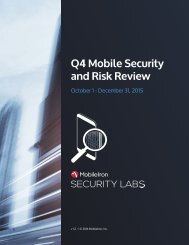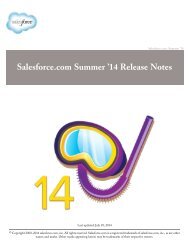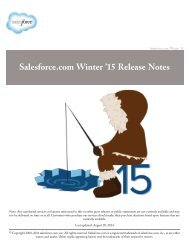salesforce_security_impl_guide
salesforce_security_impl_guide
salesforce_security_impl_guide
Create successful ePaper yourself
Turn your PDF publications into a flip-book with our unique Google optimized e-Paper software.
Securing and Sharing Data<br />
Profiles Overview<br />
Profiles Overview<br />
Profiles contain user permissions and access settings that control what users can do within your<br />
organization.<br />
Watch how you can open up access to records using the role hierarchy if your<br />
organization-wide defaults are more restrictive than Public Read/Write.<br />
Who Sees What: Record Access via the Role Hierarchy<br />
EDITIONS<br />
Available in:<br />
• Enterprise<br />
• Performance<br />
• Unlimited<br />
• Developer<br />
• Database.com<br />
A profile is a collection of settings and permissions that defines how users with particular profile<br />
access records, how they see their data, and what they can do within the application. For Salesforce CRM Group and Professional Editions,<br />
you can use the standard Salesforce CRMprofiles but you can’t create custom profiles. Even so, it’s important to understand profiles and<br />
how they work together with the organization-wide defaults and the role hierarchy. The most important profiles include:<br />
• System Administrator –Can configure and customize the application<br />
• Standard User –Can run reports and create and edit records<br />
• Read Only –Can run and export reports and view—but not edit—recordsWhen you add users as you prepare to go live, you will<br />
assign one of theseprofiles to each user.<br />
Each standard or custom profile belongs to exactly one user license type. In Contact Manager, Group, and Professional Edition organizations,<br />
you can assign standard profiles to your users, but you can't view or edit the standard profiles or create custom profiles. In Enterprise,<br />
Unlimited, Performance, and Developer Edition organizations, you can use standard profiles, or create, edit, and delete custom profiles.<br />
For standard profiles, only certain settings can be changed.<br />
Salesforce has two profile interfaces. Depending on which profile user interface is enabled in your organization, you can:<br />
• View and edit profiles in the enhanced profile user interface<br />
• View and edit profiles in the original profile user interface<br />
You can also use a list view to edit multiple profiles.<br />
12






